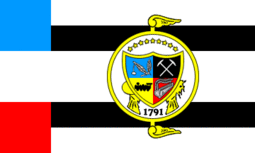Flag of Knoxville, Tennessee facts for kids
The flag of Knoxville, Tennessee is very old, adopted on October 16, 1896. It's one of the oldest city flags in the United States, and the oldest city or state flag in Tennessee!
How the Knoxville Flag Was Created
The Knoxville flag was created because of the Tennessee Centennial and International Exposition. This big event celebrated Tennessee's 100th birthday. People wanted to show pride in their city after the American Civil War.
In 1896, a lawyer named Horace van Deventer suggested making a city flag. The Chamber of Commerce held a contest for the best design. Lloyd Branson, a talented painter from Knoxville, won the contest and $100.
The City Council liked Branson's design. On October 16, 1896, they passed a law making it the official flag.
A few days later, on October 22, 1896, the Chamber of Commerce gave the first Knoxville flag to the city's mayor. This happened during a big street fair. The Morning Tribune newspaper wrote about it, saying, "The City Flag Now Floats to the Breeze from the City Hall.”
The Knoxville flag was flown during the Tennessee Centennial, which took place in Nashville in 1897. This event celebrated 100 years since Tennessee joined the United States.
In 1941, Knoxville celebrated its 150th birthday. The City Council and Mayor Fred Allen confirmed the flag's design. They made two small changes: the date on the flag became 1791 (the year Knoxville was founded), and the train on the flag was changed to look like The General train.
What the Flag's Symbols Mean
The Knoxville flag is divided into three equal horizontal parts. It is six feet tall and nine feet wide.
In the top corner near the flagpole, there's a blue square. This blue color stands for Loyalty. In the bottom corner, there's a red square, which means Bravery. The entire middle section of the flag is white, showing Faith.
From the blue and red squares, two stripes run across the flag. These stripes are black and white. They represent coal and marble, which are important resources in the area. From the blue square, the white stripe is above the black one. From the red square, the black stripe is above the white one.
In the middle of the flag, there's a golden Wheel of Progress with wings. Inside this wheel is the city's shield, also known as its coat of arms or seal. Above the shield are nine gold stars. These stars represent the nine areas, or "wards," of the city in 1896 when the flag was adopted.
The shield is supported by golden bundles of wheat and corn. These represent Agriculture, showing how important farming is. Below the shield, the numbers 1791 are written in black, showing the year Knoxville was founded.
Inside the shield, there are four sections:
- The top-left section is blue with a white derrick. This represents the Marble industry.
- The top-right section is black with crossed gold picks. This stands for different types of Mining.
- The bottom-left section is gold with a black train engine. This represents Transportation and Commerce (business).
- The bottom-right section is red with a factory. This stands for Manufacturing (making things).
Images for kids



